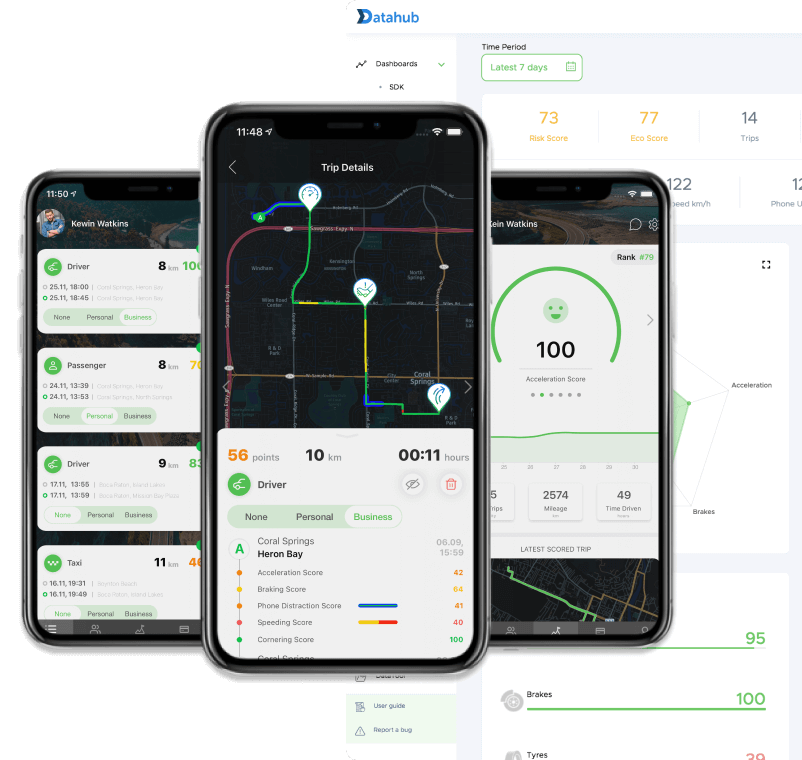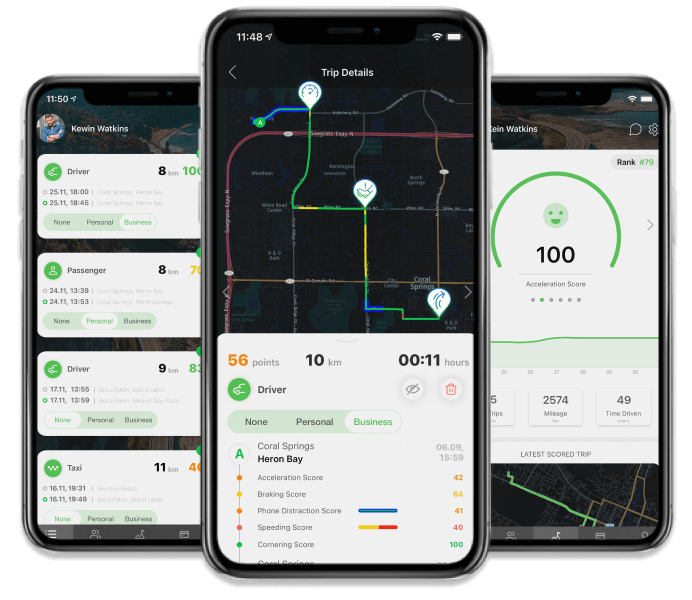The Power of Smartphone Telematics
The benefits of smartphone telematics are enormous, both in terms of safety and efficiency. In today’s increasingly connected world, it’s important to understand how to harness the power of mobile devices to make the most out of your business. One way to do this is by using smartphone telematics technology to track drivers and vehicles in real-time, helping you track performance, providing driver coaching and ensuring that your fleet runs as efficiently as possible.
Applications of Smartphone Telematics
Your smartphone is outfitted with telematics capabilities, which allow it to capture your driving data and behaviours. This information can be used to help you become a safer driver and monitor your vehicle’s condition. If you have an older vehicle without any onboard telematics capabilities, consider installing a small device that plugs into your OBD port.
Smartphone Telematics for Automobile Industry
Over time, telematics has proven itself to be an effective tool for evaluating driver performance and driving habits in general. This technology is also a useful tool for driving schools, as it allows instructors to monitor their student’s progress from one day to another and give them more personalized advice on how to improve. And when we talk about smartphones, things become even more interesting: after all, our phones are with us 24/7—in a way that’s very hard not to notice! There are plenty of apps available (and pretty affordable) that use your phone’s GPS tracking capabilities and clever algorithms to evaluate your driving skills by analyzing data such as acceleration, braking, and cornering patterns.
Smartphone Telematics for Insurance
Using telematics to your advantage by purchasing a bundled insurance policy that offers you more coverage in exchange for collecting vehicle data will help keep your premiums low, but there’s more than just cost savings to smartphone telematics. If your policy includes an anti-theft component, smartphone telematics can help increase its effectiveness. By knowing where your car is at all times and how fast it is going, your car insurance company knows where to send police if they receive a notification that your vehicle has been stolen. If you drive a work vehicle, there may also be tax benefits associated with tracking mileage via smartphone telematics.
Smartphone Telematics for Fleet Management
Driver safety is one of the many advantages of the logistics industry. Safety is a key concern for fleet owners, who are responsible for employee and public safety as well as fleet loss due to vehicle damage. With fleets on the go all day long, it’s important to be able to locate vehicles in real-time so that necessary repairs can be made promptly. Smartphone telematics can also save businesses a lot of money through fuel optimization by providing real-time driving feedback, helping drivers become more eco-friendly behind the wheel. Smartphone telematics can track drivers, not just vehicles.
Advantages of Telematics Data Collection with Smartphones
Products suites comprising Apps and management dashboard are used to analyze fuel consumption, driving habits, brakes, and other parts of a truck. When combined with smartphones with GPS and accelerometers, there are many opportunities for understanding driver behaviors and patterns in real-time during deliveries and maintenance-related trips.
Accurate Assessment of Driving Behaviour
A key feature of smartphone telematics is its ability to collect accurate data from mobile phones, which has led to it becoming a huge industry in its own right. Some companies offer smartphone telematics services for vehicle tracking and management, but what does that mean? Essentially, using software on your phone, companies can track driving behaviour in terms of speeding or harsh braking for example. This information is then used by driving schools and fleet managers to offer driver training courses as well as monitor drivers who are at risk of making mistakes on the road.
Cost and Data Footprint Optimization with Elimination of Telematics Hardwares
Most of today’s telematics service platforms require expensive hardware solutions installed in vehicles to track driving patterns and remotely monitor performance. But traditional telematics solutions are now often replaced by more advanced smartphone telematics solutions, reducing costs and data footprint by as much as 50%. Eliminating hardware is often sufficient to drive down overall costs while increasing data-collection frequency, leading to better overall analytics capabilities. In addition, a smartphone telematics solution is far less complicated than its predecessor and supports an array of sensor-based monitoring for even deeper insights into driver behaviour. The result is better insights at a lower cost with greater functionality.
Accessibility and Convenience
These days, it’s much easier to be able to track your vehicle. No longer do you have to go out and physically look for your car; by downloading an app onto your smartphone, you can know right where it is. The best part about these systems is that they are completely unobtrusive—nothing has to be wired into your vehicle and there’s no onboard unit (OBU) anywhere in sight. Rather, all communication goes through a cellular network or via GPS alone. In addition, because it requires nothing to be physically attached to your vehicle or placed inside, you won’t need any special tools or mechanical skills—anyone can install telematics tracking and start tracking their vehicle in under 15 minutes!
Vehicle Compatibility
The first step to using a phone for vehicle tracking is to find a phone that’s compatible with vehicle tracking. This includes older phones or smartphones and newer vehicles. Make sure your phone is up-to-date as new models come out constantly, many of which aren’t supported by smartphone telematics yet. Before you even start looking at models, make sure that you’ve read over all manufacturer installation requirements, too. For example, some require certain versions of iOS or Android before they’ll work with their apps.
Portability
You don’t have to be a member of AAA or CAA or even own a car to take advantage of vehicle tracking. Often, users will request vehicle tracking systems if they rent vehicles frequently. In these cases, having vehicle tracking is as simple as putting an OBD (on-board diagnostics) device into their rental car. So, it’s portable!
Challenges of Telematics Data Collection using Smartphones
The smartphone is arguably one of the most powerful tools in today’s automotive repair arsenal, as it allows for easy transmission and collection of data about vehicle performance. In addition, though it is not common knowledge outside certain sectors, smartphones are not designed for 24/7 monitoring. The ability to send and receive text messages or go online via a wireless network may drain battery life significantly when used constantly over long periods. This can result in dropped connections with significant gaps in recorded data that render an analysis incomplete or inaccurate.
Lack in the Consistency of Smartphone Operating Systems
Although telematics service platforms will allow for more dynamic vehicle connectivity, experts believe that a lack of consistency between major smartphone operating systems is hindering progress. While iOS and Android accounted for about 70 percent of global smartphone shipments, it is predicted that Windows and Linux-based mobile devices will soon outnumber their Apple and Google counterparts. Nevertheless, due to high levels of fragmentation within open-source operating systems like Firefox OS and Tizen OS which are installed on fewer than 0.5 percent of smartphones globally, many manufacturers have shied away from using them.
False Car Crash Detection & Inaccuracy of Vehicle Health
Vehicles with OnStar or a similar telematics service platform often alert users to possible problems. However, some customers have reported that these systems provide an unnecessary amount of information about potential vehicle damage and rarely are correct in their warnings. A few customers have even allegedregedported that these systems have falsely alerted them about accidents and vehicle damage when there was none. Driver’s report feeling stressed and inundated by these reports, making it difficult to discern which messages may be correctserious. Additionally, many telematics services track when and where vehicles are driven – but only if users give explicit permission for such tracking. Those who aren’t aware they’ve given consent may feel violated when they prealize they’re being tracked by their lookpvehicles’ health reports.
Regulatory Approvals
In many cases, these apps need to comply with applicable federal, state, and local laws and regulations. These laws vary from place to place, so telematics app developers must understand them and develop products accordingly. This will help ensure that they can service their clients across a wide range of geographies while complying with all applicable rules and guidelines. Incorporating flexibility in development not only helps streamline operations; it also ensures regulatory compliance and makes new business opportunities more accessible.
Conclusion
Today’s business world is dependent on new technologies and advancements to succeed. Telematics systems are a great example of this, with prices getting more reasonable every day and companies taking advantage of these advancements for various tasks.
Are you looking for ways to stay ahead of the competition? Damoov specializes in connecting all sorts of companies with a robust set of cutting-edge mobile telematics services that can help them make better decisions, save time and money, and expand their customer base. Contact us today to learn more!
Useful links
- Company website: https://damoov.com
- Open-source telematics app: https://damoov.com/telematics-app
- Telematics SDK: https://damoov.com/telematics-sdk
- Telematics API: https://damoov.co/api-services
- Developer portal: https://docs.damoov.com
- Datahub: https://app.damoov.comm
- Github: https://github.com/Mobile-Telematics



